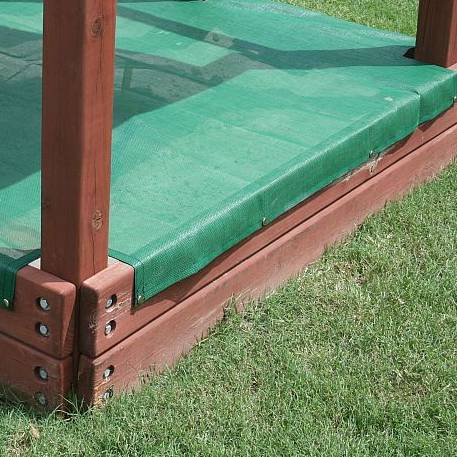
Kids don’t need complicated, technologically advanced toys in order to tap into the powers of their creativity and imagination. All that’s needed to get kids’ creative juices flowing are open-ended basics that can be found easily and inexpensively. One popular example of this kind of toy is a
sandbox. A big box or pit of sand and a few simple tools can keep kids occupied for hours.
Making sure that the sandbox stays in good shape, though, is essential to ensuring that it remains a safe and healthy place to play. Unfortunately, the backyard sandbox is often overlooked when it comes to play area maintenance. Here are four quick and easy tips for maintaining your backyard sandbox:
1. Replace the sand.
Over time, the sand in outdoor sand pits or sandboxes gets dirty and needs to be replaced. Generally speaking, replacing sand every year or two should be adequate, but more frequent changes may be necessary depending on how often children play in the box and whether a sandbox cover is used on a regular basis. Play sand, rather than building sand, is the best choice for children’s play areas because it is cleaner and free of materials, like clay, that may stain skin and clothing.
2. Inspect sand toys.
Shovels, rakes, and other toys intended for sand play are not usually the sturdiest of tools. As a result, they don’t often last for more than a season or two. When sand toys or other tools used in the sandbox break, they can have sharp edges or pointy parts that can cause injuries. Before allowing kids to play in the sandbox this season, ensure that their sand toys are in good shape. Toss out any broken or worn out tools, and replace them with newer, sturdier varieties.
3. Check sand regularly.
Don’t assume that the sandbox will stay in the same good shape throughout the spring and summer. Sharp sticks, rocks, and other debris find their way into play sand quite easily, and sand toys may not be able to withstand the stresses put upon them by children during active play. Checking the sand on a weekly basis allows you to remove any potentially harmful debris and broken toys. You may also find that replenishing the play sand during these check-ups is necessary, especially if kids have spent any time shoveling it out of the box.
4. Cover the sandbox.
Sandbox covers are not used as widely or as often as they should be, but they are one of the easiest and most important ways to maintain a safe and healthy sandbox. When used properly, sandbox covers prevent excess debris, like leaves, sticks, and rocks, from falling into the sand and creating a potential danger to children.
Sandbox covers also protect sand from blowing away in heavy winds, and they keep insects from making a home in the sand. Most importantly, sandbox covers prevent play sand from being contaminated by animals who like to use the sandbox as a bathroom.
The key to using sandbox covers successfully, of course, is to use them regularly when children are not playing in the box. Use sandbox covers that are made to fit your sandbox. Tarps and other makeshift covers can be easily removed or dislodged by animals or strong winds, making them ineffective and unreliable.
Overall, maintaining the backyard sandbox is an easy task that requires little time and few supplies. Keeping play areas healthy and safe for your kids will give you peace of mind, and will provide your kids and their imaginations with hours of good, clean, simple fun.


Hello,
I have a 6×6 sandbox area underneath the tower of my swingset. I want to make this area a sandbox for my children but we purchased this swingset 10 years ago and the company I did business with no longer deals with swingsets. Our swingset is vinyl (white with green accessories) so I would prefer the sandbox cover be green or gray. My question is can I use your custom sandbox covers and screw the snaps into the vinyl?